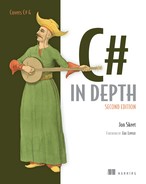List of Figures
Chapter 1. The changing face of C# development
Figure 1.1. Evolution of the Product type, showing greater encapsulation, stronger typing, and ease of initialization over
time
Figure 1.2. Features involved in making sorting easier in C# 2 and 3
Figure 1.3. Anonymous methods and lambda expressions aid separation of concerns and readability for C# 2 and 3.
Figure 1.4. Options for working with “missing” data
Chapter 2. Core foundations: building on C# 1
Figure 2.1. Processing a call to a delegate instance that uses the C# shorthand syntax
Figure 2.2. The transformation process used for the C# shorthand syntax for combining delegate instances
Figure 2.3. Comparing value type and reference type behaviors, particularly with regard to assignment
Chapter 3. Parameterized typing with generics
Figure 3.1. Unbound generic types act as blueprints for constructed types, which then act as blueprints for actual objects,
just as nongeneric types do.
Figure 3.2. The anatomy of a generic method declaration
Figure 3.3. Visual demonstration of why List<T> takes up a lot less space than ArrayList when storing value types
Figure 3.4. Interfaces for shapes and drawings, and two implementations of each
Chapter 4. Saying nothing with nullable types
Figure 4.1. Sample values of Nullable<int>
Figure 4.2. Results of boxing an instance without a value (top) or one with a value(bottom)
Chapter 5. Fast-tracked delegates
Figure 5.1. Snapshot of multiple captured variable scopes in memory
Chapter 7. Concluding C# 2: the final features
Figure 7.1. Code in partial types is able to see all of the members of the type, regardless of which file each member is in.
Figure 7.2. Comparison between XAML precompilation and autogenerated entity classes
Figure 7.3. Part of the Properties window of Visual Studio 2010, showing an extern alias of FirstAlias for the First.dll reference
Chapter 8. Cutting fluff with a smart compiler
Figure 8.1. Transformation of an automatically implemented property
Figure 8.2. Hovering over var in Visual Studio displays the type of the declared variable.
Figure 8.3. Hovering over the use of an implicitly typed local variable displays its type.
Figure 8.4. Hovering over a variable that’s declared (implicitly) to be of an anonymous type shows the details of that anonymous
type.
Figure 8.5. Anonymous types allow you to keep just the data you need for a particular situation, in a form that’s tailored
to that situation, without the tedium of writing a fresh type each time.
Chapter 9. Lambda expressions and expression trees
Figure 9.1. Lambda syntax shortcuts
Figure 9.2. Graphical representation of the expression tree created by listing 9.6
Figure 9.3. Type hierarchy from Expression<TDelegate> up to Expression
Figure 9.4. Graphical representation of expression tree that calls a method and uses parameters from a lambda expression
Figure 9.5. Debugger visualization of an expression tree
Figure 9.6. Both LINQ to Objects and LINQ to SQL start with C# code and end with query results. The ability to execute the
code remotely comes through expression trees.
Figure 9.7. The two-phase type inference flow
Chapter 10. Extension methods
Figure 10.1. Hovering over a method call in Visual Studio reveals whether the method is actually an extension method.
Figure 10.2. Pulling apart a fluent interface expression to create a meeting. The time of the meeting is specified using extension
methods to create a TimeSpan from an int, and a DateTime from a TimeSpan.
Chapter 11. Query expressions and LINQ to Objects
Figure 11.1. A simple query expression broken down into the sequences and transformations involved
Figure 11.2. Sequence diagram of the execution of a query expression
Figure 11.3. Class diagram of the SkeetySoft defect data model
Figure 11.4. A simple query expression broken down into its constituent parts
Figure 11.5. Sequences involved in listing 11.11, where a let clause introduces the length range variable
Figure 11.6. The join from listing 11.12 in graphical form, showing two different sequences (defects and subscriptions) used
as data sources
Figure 11.7. Sequences involved in the group join from listing 11.13. The short arrows indicate embedded sequences within
the result entries. In the output, some entries contain multiple email addresses for the same defect.
Figure 11.8. Sequences from listing 11.15, cross joining users and projects. All possible combinations are returned in the
results.
Figure 11.9. Sequences used when grouping defects by assignee. Each entry of the result has a Key property and is also a sequence
of defect entries.
Chapter 12. LINQ beyond collections
Figure 12.1. The LINQ to SQL classes designer showing the rearranged and modified entities
Figure 12.2. Class diagram based on the interfaces involved in IQueryable<T>
Figure 12.3. A query taking two paths, depending on whether the data source implements IQueryable or only IEnumerable
Figure 12.4. Class diagram for LINQ to XML, showing the most commonly used types
Figure 12.5. Mandelbrot image generated on a single thread
Figure 12.6. Class diagram for Parallel LINQ, including relationship to normal LINQ interfaces
Figure 12.7. Mandelbrot image generated using an unordered query, resulting in some sections being incorrectly placed
Figure 12.8. Sequence diagram showing the duality of IEnumerable<T> and IObservable<T>
Chapter 13. Minor changes to simplify code
Figure 13.1. Declaring optional parameters
Figure 13.2. Positional and named arguments in the same call
Figure 13.3. Mixing named arguments and optional parameters
Figure 13.4. Linking PIAs in Visual Studio 2010
Figure 13.5. Comparing referencing and linking
Chapter 14. Dynamic binding in a static language
Figure 14.1. How the components of .NET 4 fit together, allowing static and dynamic languages to execute on the same underlying
platform
Figure 14.2. Lifecycle of a dynamic expression
Figure 14.3. Relationships between dynamic caches and call sites
Figure 14.4. Tree structure of sample XML file
Figure 14.5. Selecting data using DynamicXElement
Figure 14.6. Visual Studio 2010 displaying dynamic properties of a DynamicXElement
Chapter 15. Letting your code speak more clearly with Code Contracts
Figure 15.1. Code Contracts project property page in Visual Studio 2010
Figure 15.2. Static check results in Visual Studio 2010
Appendix B. Generic collections in .NET
Figure B.1. Interfaces in System.Collections.Generic
